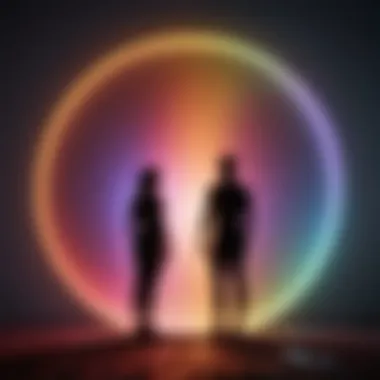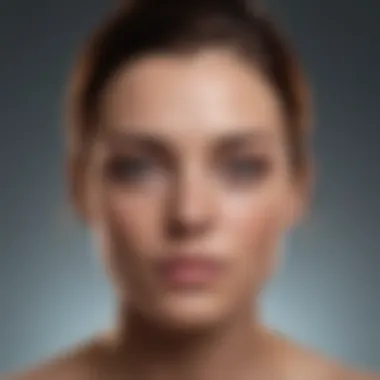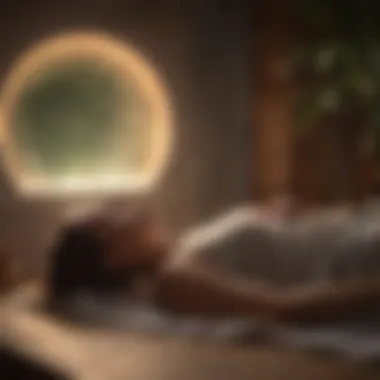Exploring Aura Viewing: Science and Perspectives


Intro
Aura viewing rests at the intriguing crossroads of perception and belief. It captivates not just the curious mind but also those seeking deeper understandings of human experience. Historically, the concept of aura has found a place in various cultural traditions, recognized for its potential to reflect an individual’s emotional state or overall well-being. This intersection represents a blend of subjective experience and possible scientific scrutiny, raising questions about the nature of human perception and its implications.
The journey of exploring auras encompasses historical perspectives, various methodologies, and ongoing debates within the scientific community. Understanding the significance of aura viewing demands a careful examination of the methods and the underlying psychological constructs. Furthermore, it prompts an exploration of its applications in modern contexts, particularly in mental health and holistic practices, aiming for a comprehensive view that encompasses both traditional beliefs and contemporary scientific inquiry.
As we delve into this subject, we aim to unravel the nuanced connections between personal perceptions and broader implications. This report elaborates on key findings, methodological approaches, and the relevance of aura viewing within current scientific discussions.
Preamble to Aura Viewing
Aura viewing represents a domain where subjective human experience meets inquiry into the unseen aspects of existence. This topic holds significance not just for those interested in alternative beliefs but also for researchers, psychologists, and healthcare professionals. Understanding auras can enhance knowledge about emotional health, interpersonal dynamics, and spiritual awareness. As we delve into this topic, we must consider the various dimensions involved—defining concepts clearly, appreciating historical context, and recognizing cultural perceptions.
Defining the Aura
An aura is commonly perceived as a subtle energy field surrounding a person or living being. Some interpret this energy as a visual manifestation of emotional states, health conditions, or spiritual well-being. Traditionally, auras are described with colors that supposedly indicate specific traits or feelings. For instance, a bright yellow may suggest a person who is intellectually inclined, while a muddy brown could reflect emotional turmoil. While many scientists remain skeptical, the definition of an aura has spurred considerable discussion and exploration in both spiritual and psychological disciplines.
Historical Context
The concept of an aura is not modern; it has roots in various ancient cultures. For instance, in medieval times, individuals believed that saints radiated a sacred light, often depicted in art as a halo. Additionally, theosophical societies in the 19th century expanded ideas regarding auras, linking them to spiritual health. Systematic studies began in the 20th century when researchers like Walter Kilner used special filters to observe auras, although conclusive scientific evidence remained elusive. Appreciating this historical context allows us to recognize how perceptions of auras have evolved and gained cultural meaning over time.
Cultural Perspectives
The understanding of auras varies significantly across cultures. In Indian traditions, auras are related to the chakras, where each energy center correlates with specific emotional and physical aspects of life. In contrast, Western interpretations often align auras with psychological states or energies and may incorporate holistic practices. This divergence in cultural perspectives highlights that aura viewing is more than just mere observation; it is a practice embedded within a larger framework of beliefs, spirituality, and healing.
"Auras provide a window into the unseen forces that shape our experiences. Exploring them can enhance personal insight and holistic well-being."
Methods of Aura Viewing
Understanding the methods of aura viewing is essential for comprehending how individuals interpret and perceive auras. This section explores the various techniques developed over time, illustrating their purposes and significance. These methods range from traditional practices rooted in history to modern advancements utilizing technology. Each approach offers distinct insights, emphasizing the subjective experience of aura viewing and its implications for personal understanding.
Traditional Techniques
Traditional methods of aura viewing have been practiced for centuries. These techniques often stem from ancient beliefs and cultural rituals that view auras as reflections of one’s emotional and spiritual state. One common technique involves meditation and visual focus, where practitioners enter a quiet mental space to enhance their sensitivity to the surrounding energy fields.
Another well-known traditional practice is the use of colored filters or crystals. By holding certain colors near the eyes, individuals believe they can amplify their perception of auras. This practice aligns with color therapy principles, where colors are said to correspond to emotional and spiritual energies.
While the effectiveness of these techniques is debated, many enthusiasts find value in the ritualistic aspects, contributing to a sense of connection to the universe. Traditional methods serve as a foundation, evolving to include newer practices that align with contemporary beliefs.
Modern Practices
In the contemporary context, aura viewing has embraced a blend of psychology and holistic practices. Many people utilize visualization techniques, which involve imagining colors and energies surrounding individuals. This method is often complemented by breathing exercises to enhance focus and mindfulness.
Another modern approach is the use of guided imagery, where practitioners rely on meditation sessions led by experienced individuals. Through verbal guidance, one can engage deeper with the visualization process. This method helps individuals make personal connections to the colors and feelings they observe in themselves and others.
The emergence of workshops and courses on aura reading highlights the growing interest in modern practices. These educational initiatives teach participants to refine their skills and gain confidence in their abilities. The communal aspect of these sessions also supports a shared exploration of aura perceptions, adding richness to the experience.
Technological Approaches
Recent advancements in technology have opened new pathways for exploring aura viewing. Some modern techniques utilize biofeedback devices to measure emotional and physical responses. These devices often analyze physiological changes, providing data that individuals can interpret as correlating with their aura.
Another significant technological approach involves digital imaging systems designed to capture the energy field surrounding individuals. Systems like Kirlian photography aim to visualize the aura in real-time, presenting colors and shapes that allegedly represent emotional states. However, these images often lack scientific validation, leading to skepticism within the scientific community.


The use of apps for aura analysis has also emerged. These mobile applications offer users insights based on self-reported data and visual inputs, creating an accessible way for individuals to engage with aura concepts. While skepticism exists regarding such technologies, their popularity indicates a growing interest in blending science and spirituality.
The methods of aura viewing reflect a broader understanding of perception, serving as an intersection between traditional beliefs, modern practices, and emerging technologies.
The Scientific Perspective
The relevance of the scientific perspective in the context of aura viewing cannot be overstated. Scientific inquiry lends credibility to phenomena that are often dismissed as mere subjective experiences. This section addresses the empirical dimensions of aura viewing, focusing on psychological interpretations, physiological considerations, and the skepticism and criticism it faces. Understanding these aspects is essential for creating a balanced view of aura perception.
Psychological Interpretations
Psychological interpretations of aura viewing highlight the role of perception in shaping experience. Individuals who claim to see auras often report heightened emotional responses and intuitive insights. Cognitive processes, including attention and expectation, play a significant role in how auras are perceived.
Research conducted in psychology suggests that such experiences may be influenced by factors like stress and mental health. Some studies propose that individuals with certain psychological conditions, such as synesthesia, may perceive auras differently. This perception could enhance their understanding of social contexts or emotional states in others. Furthermore, psychological theories, especially those relating to the subconscious, suggest that individuals may project their own feelings and biases onto the auras they perceive.
Physiological Considerations
Physiological considerations in aura viewing involve examining the potential physical explanations behind these perceptions. Some researchers speculate about the role of bioenergetic fields or electromagnetic changes in the body, which proponents believe may correlate with emotional states. While there isn't definitive evidence to support these claims, exploring the physiological aspects can shed light on the mind-body connection.
Furthermore, tools like biofeedback and kirlian photography have been employed to visualize energy fields. However, the reliability and validity of these methods remain subjects of debate. Certain physiological theories also explore how bodily responses, such as heart rate variability, could influence an individual's perception of auras. These considerations warrant further study, as they can contribute to a more nuanced understanding of the phenomenon.
Skepticism and Criticism
Skepticism and criticism are integral to the scientific discourse surrounding aura viewing. Many scientists remain unconvinced of the evidence presented by advocates of aura perception. Critics often argue that anecdotal experiences lack the rigor required for scientific validation. The subjective nature of aura viewing raises questions regarding its reproducibility and generalizability.
To illustrate, there are fundamental concerns about confirmation bias in aura perception. People may interpret ambiguous stimuli in a way that confirms their pre-existing beliefs about auras. Moreover, the psychological phenomenon known as pareidolia, where the mind sees patterns or images in random data, can offer alternative explanations. Critics emphasize the need for controlled studies to separate genuine perceptions from psychological projections. Progress in establishing scientific consensus hinges on addressing these skepticism points through rigorous empirical research.
A nuanced understanding of aura viewing requires integrating psychological interpretations, physiological insights, and addressing skepticism critically.
Personal Implications of Aura Viewing
Understanding the personal implications of aura viewing is crucial. It connects subjective experience with various practical aspects of life. The perceived benefits can influence mental health, spiritual development, and interpersonal dynamics. Recognizing the potential of aura viewing enhances its relevance in therapeutic and personal growth contexts. This section will explore specific elements that highlight the importance of this concept.
Mental Health Perspectives
Aura viewing might play a role in mental health management. It can serve as a tool for self-reflection and emotional awareness. Many individuals report that they feel more in tune with their emotions when they engage in aura viewing practices. This heightened awareness can lead to improved psychological well-being.
Some practitioners use aura interpretation as part of therapeutic sessions. They believe that understanding auras can reveal emotional states and psychological blockages. Clients may gain insights into their mental health, allowing for deeper discussions with therapists. While studies on this realm are limited, anecdotal evidence suggests a positive impact on clients' therapeutic processes.
"The ability to perceive and understand auras can unlock the door to personal emotional insights that transform one’s mental health journey."
Spiritual Growth
Spiritual growth is another significant aspect of aura viewing. For many, the practice serves as a gateway to exploring deeper spiritual beliefs. Seeing auras often fosters a sense of connection to oneself and the universe. This can inspire individuals to seek higher states of consciousness.
The exploration of one's aura may induce a meditative state, further enhancing spiritual awareness. Individuals engage with their auras to promote healing, balance, and alignment in their lives. Spiritual practitioners often encourage regular aura viewing as part of their routines, believing it strengthens intuition and personal power.
Spiritual practices are subjective and highly personal. Thus, what resonates with one individual may not with another. Engaging with aura viewing allows exploration of diverse belief systems and expands spiritual horizons.
Interpersonal Relationships
Interpersonal relationships can be significantly impacted by aura viewing. The ability to perceive others' auras may enhance empathy and understanding in interactions. Recognizing the emotional layers of others helps to navigate complex social situations more effectively.


People who engage in aura viewing often report improved communication. Understanding another's emotional state can lead to more compassionate responses. This can deepen connections, as individuals move beyond surface-level interactions.
Moreover, it can foster greater conflict resolution skills. When individuals look beyond words and actions to understand underlying emotional contexts, misunderstandings can diminish. Such insights foster intimacy and healthy relationships, making aura viewing a potentially valuable skill in personal connections.
Professional Applications of Aura Viewing
The exploration of aura viewing transcends mere observation. It is becoming an essential component in various professional domains. Understanding the practice's potential can enhance therapeutic outcomes, improve coaching methods, and inspire creativity in artistic expression. This section delves into these professional applications, highlighting their significance in the broader context of personal and social well-being.
In Therapeutic Practices
In the field of therapy, aura viewing offers distinct benefits. Some therapists use it to gain insights into their clients' emotional and psychological states. Auras can reflect inner turmoil or peace, allowing professionals to tailor their approaches more effectively. This practice often complements existing techniques, creating a holistic view of the client's mental health.
"Therapeutic applications of aura viewing can lead to a deeper understanding of emotional distress and its root causes."
The implications can be substantial. By observing changes in auras over time, therapists can measure progress. They may also identify patterns that correlate with the client's experiences, fostering more productive therapeutic sessions. However, practitioners should approach this practice with caution, ensuring clear communication about the subjective nature of aura perceptions.
In Coaching and Training
In coaching and training, aura viewing can serve as a tool for personal development. Coaches who grasp the nuances of aura perception can guide individuals toward greater self-awareness. It allows clients to explore their motivations and barriers. A practitioner might notice shifts in a client's aura when discussing specific topics, which can reveal deeper issues that need addressing.
Benefits abound in this domain. Clients can gain insights into their strengths and weaknesses, allowing for focused improvement plans. Training sessions may become more tailored, promoting effective learning. Still, potential misconceptions regarding aura interpretation could mislead clients. Coaches must be mindful and grounded in practical outcomes.
In Artistic Expression
Artists have long sought inspiration from various sources, and aura viewing is no exception. Some creatives claim that viewing auras enhances their work. The ambiance and vibrancy of auras can influence themes, colors, and expressions in their creations.
Aura observations can lead to unique artistic interpretations, allowing for a personal connection to their art. This connection resonates with the viewer, potentially creating an emotional response. However, artists should ponder the balance between inspiration and personal emotion. Excessive reliance on aura viewing may hinder authenticity in their work.
Challenges and Controversies
The topic of challenges and controversies surrounding aura viewing plays a pivotal role in this article. Understanding these elements is essential for anyone interested in this subject, as they bring to light the various perspectives and implications associated with aura perception. The interaction of skepticism, ethical considerations, and misinformation shapes the discourse around aura viewing and its acceptance in both scientific and public arenas. By discussing these challenges, we can better navigate the landscape of aura research and appreciate the complexities involved.
Debates within Scientific Circles
The scientific community presents a mixed response to the concept of aura viewing. While some researchers strive to uncover the physiological basis for aura observation, others remain skeptical. Critics often argue that there is insufficient empirical evidence to substantiate claims. They emphasize the need for rigorous methodological approaches that can provide concrete data.
Supporters of aura research suggest that dismissing subjective experiences entirely overlooks the nuances of human perception. They advocate for a more exploratory approach, one that considers both qualitative and quantitative analyses. This ongoing debate highlights a crucial tension in science, where subjective experiences often clash with the demand for objective evidence.
Ethical Considerations
Ethics also come into play when discussing aura viewing. As practitioners, therapists, or coaches incorporate aura perception into their work, ethical boundaries must be established. This includes ensuring that clients understand the nature of aura readings and the potential implications of this information.
Furthermore, there can be risks of dependency or misinterpretation, particularly when clients place significant trust in these readings. Practitioners need to communicate clearly about the limitations of their insights and avoid making unfounded claims. This promotes transparency and supports a healthier approach to spiritual or psychological well-being.
Misinformation and Misrepresentation
Misinformation in the field of aura viewing can lead to misunderstanding and skepticism. The proliferation of sensational claims and dubious practices muddles the conversation, making it difficult for individuals to discern trustworthy information. This can harm genuine researchers and practitioners who aim to approach aura viewing with integrity.
It is important to scrutinize sources and differentiate between anecdotal evidence and scientifically supported claims. Educating the public about the complexities of aura viewing can help mitigate misunderstandings and foster a more informed discourse. Accurate representation of research findings is paramount for establishing credibility and furthering constructive dialogue.
"The exploration of aura viewing encompasses a spectrum of experiences, raising essential questions in science, ethics, and public perception."


In summary, the challenges and controversies within the realm of aura viewing are multifaceted. They involve ongoing debates in scientific circles, ethical considerations in practice, and the pervasive influence of misinformation. Addressing these issues is critical for advancing understanding and appreciation of aura perception.
Future Directions in Aura Research
The study of aura viewing presents a complex landscape of possibilities and challenges. It is essential to explore future directions in research to understand better and validate the nuances of this field. There is a growing interest in scientifically examining aura viewing, which could help bridge the gap between subjective experience and empirical data. Exploring further research opportunities can provide insights into human perception, consciousness, and holistic health.
Potential Scientific Studies
Future scientific studies can focus on quantifying the phenomenon of aura viewing and its implications. Researchers might explore how people report experiencing auras and identify any patterns in these accounts. Controlled experiments, possibly using tools such as functional magnetic resonance imaging (fMRI), could help assess whether there are observable brain activity changes when an individual claims to see an aura.
Additional areas for investigation may include:
- Demographic Variations: Investigating if age, gender, or cultural background influences aura perception.
- Psychological Aspects: Examining the mental states of those who see auras and how these states correlate with other psychological measures.
- Physiological Factors: Understanding if there are biological markers that can be associated with the ability to see auras, such as genetic predispositions.
These studies can enhance the understanding of the phenomenon by embedding it within a scientific framework, thus making it more accessible for traditional research environments.
Expanding Methodologies
Adapting methodologies to include a broader range of research tools is critical. Traditional qualitative approaches, such as interviews and surveys, should be combined with quantitative research methods. This combination could allow researchers to gather comprehensive data on the phenomenon.
The incorporation of technology, such as biofeedback and color analysis, could offer new perspectives on aura visibility. For instance:
- Technological Approaches: Utilizing thermal imaging to observe temperature variations around individuals as related to claimed aura views.
- Biofeedback Mechanisms: Assessing physiological responses, like heart rate variability, to determine if they correlate with aura viewing experiences.
By expanding methodological frameworks, researchers can build a more multidimensional understanding of aura perception.
Bridging Disciplines
The study of aura viewing inherently lies at the intersection of various fields, including psychology, medicine, and art. Bridging these disciplines can lead to richer insights and innovative research approaches. Collaborative efforts among psychologists, neuroscientists, artists, and traditional healers could provide a more holistic understanding of aura viewing's implications on well-being.
Interdisciplinary studies might focus on:
- Integrative Health Practices: How aura viewing fits into therapeutic practices like Reiki or acupuncture.
- Psychological Insights: The potential for aura interpretation to enhance emotional intelligence and personal development.
- Artistic Exploration: Investigating how visual artists translate their perceptions of auras into different artistic mediums.
Engaging in interdisciplinary conversations can foster a collaborative research environment, advancing both the scientific understanding and cultural significance of aura viewing.
As research into aura viewing advances, it is crucial for scholars to remain open to diverse viewpoints while maintaining scientific rigor. Such an approach may unveil profound connections between human consciousness and the spectrum of perception.
Closure
The conclusion of this article plays a vital role in summarizing the multifaceted exploration of aura viewing. As this piece reflects on the interplay between subjective experiences and scientific inquiry, it encourages the readers to consider both the personal and societal implications of aura perception.
Summary of Key Insights
The insights gathered throughout the article underline some critical aspects of aura viewing:
- Historical Significance: Understanding the roots of aura perception helps in grasping its cultural relevance.
- Diverse Methods: The range of techniques used for aura viewing, from traditional practices to modern technological approaches, sheds light on its evolving nature.
- Scientific Examination: The article stresses the necessity of scrutinizing aura viewing through psychological and physiological lenses while also acknowledging skepticism.
- Personal Implications: Aura viewing has implications for mental health, spiritual growth, and personal relationships, which could enrich individual experiences and enhance well-being.
- Professional Applications: There is growing interest in the use of aura readings in therapeutic and coaching contexts, indicating its relevance in modern practices.
These insights contribute to a broader understanding of aura viewing, supporting the need for further exploration and study.
Final Thoughts
In concluding this examination, it is noteworthy that while aura viewing remains a controversial and often debated topic, its implications are profound. Engaging with this subject may open up new avenues not only for individuals seeking better understanding of themselves but also for professionals in various fields.
The ongoing discussions around this topic can lead to potential advancements in psychological and holistic health fields. It is essential to approach aura viewing with a balanced perspective, acknowledging both its anecdotal richness and the scientific need for validation. Future research is paramount in bridging the existing gaps between personal experience and empirical evidence.
Aura viewing is not merely about perceiving colors; it can serve as a tool for self-discovery and growth, challenging norms in mental health and wellness.



